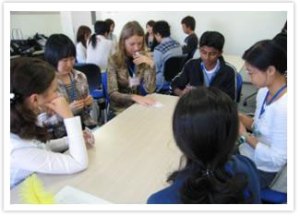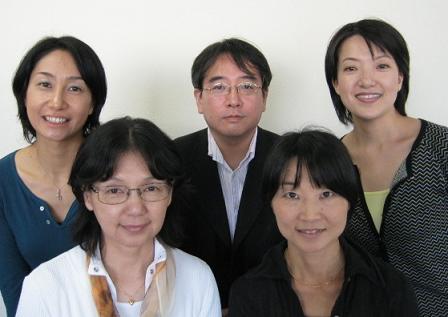University Wide Liberal Arts -Exploration of Japan:From the Outside Looking In
| Lecturer | Masachika UKIBA, Professor |
|---|---|
| Department | Institute of Liberal Arts & Sciences, 2014 Fall |
| Recommended for: | All Nagoya University students (2・1.5 hours / session 1 session / week 15 weeks / semester) |

Course Overview
In the first part of this course, we will introduce the various issues that international students often face in their daily lives in Japan. All participants, including Japanese and international, will be invited to open discussions to exchange their perspectives on specific issues. In the second part of this course, students will be divided into several multicultural groups of 6-8 students, and each group will work together for a group presentation on a research topic of their choice about Japanese culture. Throughout the preparation process with group members, students will be encourage to pay attention to learn how to communicate more smoothly and effectively with people of different cultural and language backgrounds.
Students will take a central role in this course. Students are strongly encouraged to take an active part in the classes and the group work by expressing their own opinions on intercultural communication experienced inside and/or outside of the course. Several professors from the Education Center for International Students will organize and coordinate this course for the purpose of bringing up topics and facilitating student progress. At the end of each lecture, the students are asked to fill out a questionnaire to give feedback on the course.
Key Features
Nagoya University has over 1200 international students. At the same time more and more students are going abroad through exchange programs from our university. Therefore, in this class we intend to deepen students' understanding of Japan through collaborative work of students from various cultural backgrounds. Also, we encourage students to consider what it means to them to be in a society where various people with different cultural backgrounds are living and cooperating with each other. We will also think about how multiculturalism can be achieved in our society.
Experiential learning
Study abroad experience is full of inspiring and surprising happenings, and is also psychologically intensive experience. This course will give you an opportunity to experience "cultural gaps," or what it is like to be in a different culture. We will prepare a couple of intercultural simulation games, which will offer you some insights to look into various challenges of study abroad experience.
Good chance to meet with international students
All the international students here are now experiencing what it is like to go abroad and study. Therefore for those who are willing to go abroad for exchange programs, it is going to be a valuable experience to be in contact with international students and think about cultural gaps you might face in the future. In this class, Japanese and international students will share the learning experience. The language used in this class is Japanese. Therefore, Japanese students have an important role to explain difficult terms with easy words. The number of students will be limited to about 30 people, including 15 Japanese and 15 international students.
Group projects
In this course, we will discuss various issues in Japanese society or culture with in small groups. It is eye-opening experience for Japanese students to think about Japan from different cultural perspectives. For example, frequently asked questions are 'why do Japanese people like comic books?' or 'Why are there a lot of people sleeping in the subway?'. Of course there a lot of possible answers for these questions. However, the important part of this class is to experience the process of integrating opinions into the final presentation through discussion with your group members and to understand the importance of communication.
Class organized by several professors
Several professors are responsible for organizing this course. They will be attending most of the sessions to perceive students' responses to various issues given in the course and give feedback from different perspectives. We also recognize that the significance of collaborative teaching which allow us to maximize students' learning by communicating each other regarding contents of each session.
Students Accomplishments
Note: All files are in Japanese.
Instructor & Advisors
Instructor: Ukiba Masachika
Advisor: Matsuura Machiko, Tanaka Kyoko, Horie Miki and Takaki Hitomi

Course Aims
The main course objective is for both Japanese and international students to deepen understanding of Japanese culture and society through collaborative work. Also we will explore the meaning and significance of cultural diversity on Nagoya University campus and its surrounding community.
Textbooks
No textbook is assigned. Handouts are given at the lectures.
Class room
Education Center for International Students, 2F 207.
Note
This class consists of undergraduate students from all departments, Japanese Language and Culture Course students, and the Introductory Program for Korean Engineering Students.
Course Schedule
| Session | Contents |
|---|---|
| 1 | Orientation (1) (Ukiba) |
| 2 |
Orientation (2) (Ukiba)
Self introduction, Questionnaires. |
| 3 | International students and Japanese society (Matsuura) |
| 4 | Connection with different culture (Tanaka) |
| 5 | Cross cultural communication (Horie) |
| 6 |
Introduction on group project (Ukiba, Takaki)
We divide our class into several groups for group presentations. Only the next two sessions will be used for the preparation of presentations, so it is important to also prepare outside of the lecture. Therefore, after this class I would like you to decide on a theme, meeting time and what each of the group members will be working on to get ready for the presentation. |
| 7 | Preparations for the group presentation |
| 8 | Preparations for the group presentation |
| 9 | Group presentation and discussion |
| 10 | Group presentation and discussion |
| 11 | Group presentation and discussion |
| 12 | Group presentation and discussion |
| 13 | Learning from group activity (Takaki) |
| 14 | Thinking about multicultural societies (Horie) |
| 15 | Summary |
Lecture Handouts
Note: All files are provided only in Japanese.
Session #2
Session #3
Session #4
- Experiential learning on intercultural communication using cards
Session #5
Session #13
- Questionnaire on group work
Session #14
Assignments
Students have to submit a final report of 4000 letters (A4 3pages long) at the end of this course. It has to be written using word processing software. Reports written by hand will not be permitted. More information and details on the theme and writing rules will be given in December. Successful papers should be the ones that strictly follow the writing rules.
- Themes and writing rules (in Japanese).
Grading
Grading is based on your attendance, participation in the class, successful completion of assignments, group presentation and final report.
Attendance (15%)
Attendance will be taken at each lecture. If you are more than 30 minutes late, you will be considered absent.
Participation (15%)
We will ask you for self-evaluation on your participation in and contribution to the class and group discussion.
Group presentation (40%)
You will decide the theme of the presentation with your team members. Your team will have 30 minutes for the presentation. I would like you to present about 15 minutes, leaving 10 minutes for a question and answer session. Also I would like you to leave 5 min. for listeners to fill out the evaluation sheets.
Evaluation will be based on your self-evaluation of your contribution toward presentation (10%) and the group presentation itself (evaluation based on students (15%) and evaluation based on professors (15%)).
Report (30%)
The report is about 4000 letters (A4 3pages long) and it has to be written using word processing software. Reports written by hand will not be permitted. More information and details on the theme and writing rules will be given in December. Successful papers should be the ones that strictly follow the writing rules.
Last updated
May 08, 2020
